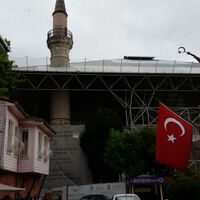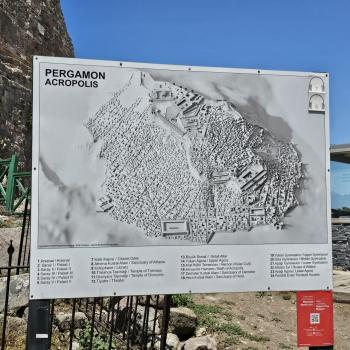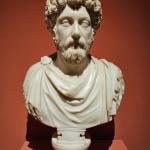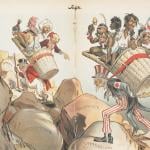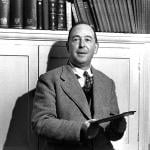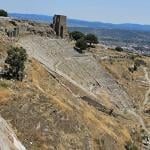The word Chora in Greek means ‘country’ and once upon a time the Chora Church in Istanbul, now a museum, was out on the country. This church is the source of various of the famous iconic mosaic images you see of Christ Pantokrator, rather than Hagia Sophia. It has been under repair for some time, and I arrived on May 22 to discover it even more under repair, both outside and in. Here is what the outside now looks like—-
And sadly, the tourist industry in Turkey has taken a huge hit from the acts of a few radicals like members of the PKK (the Kurdish party). This poor man sitting outside the church had not had a sale all day, so I bought a red fez from him, a hat at one point banned in Turkey…..

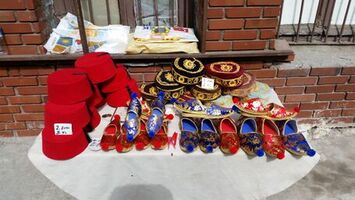
The church was built in the 5th century outside the walls of Constantine, and was a Byzantine Church, and the word Chora may have had theological import, as Christ himself in one image is called ‘the land (chora) of the living. There are two sorts of images in the church, mosaic, and fresco, with the latter being found in the chapel on the right side of the church. These images are less impressive and later. 
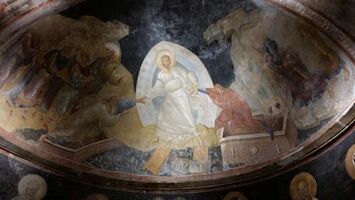
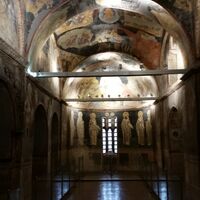
Unfortunately, the central chapel is still completely closed (as it was two years ago when I visited), and there is evidence of continuing deterioration of the mosaics, probably due to leaks in the roof, now under repair.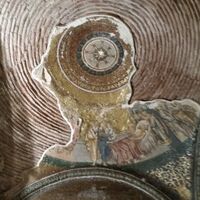 The mosaic images tell the story not only of the life of Christ but also of Mary, and of other saints like Peter and Paul, and John the Baptizer as well. In addition, we have some mosaics of Byzantine priests and rulers as well. I will focus on the religious images.
The mosaic images tell the story not only of the life of Christ but also of Mary, and of other saints like Peter and Paul, and John the Baptizer as well. In addition, we have some mosaics of Byzantine priests and rulers as well. I will focus on the religious images.
Here is the familiar image of Christ with the Lamb’s book of life in his hand, an image one sees in the narthex as one enters the chapel.
 This image is basically repeated in the dome of the narthex as well….
This image is basically repeated in the dome of the narthex as well….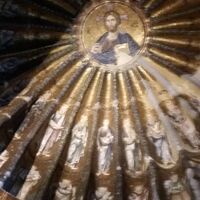 Here, at one end of the narthex we see an image of a Byzantine ruler, perhaps Theodosius, presenting the gift of either this chapel or Hagia Sophia to Jesus, probably the latter.
Here, at one end of the narthex we see an image of a Byzantine ruler, perhaps Theodosius, presenting the gift of either this chapel or Hagia Sophia to Jesus, probably the latter.
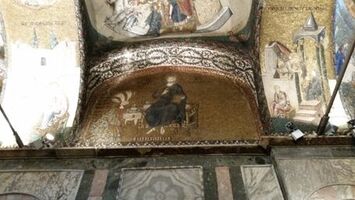
Some of the mosaic images are well preserved and still spectacular, for example….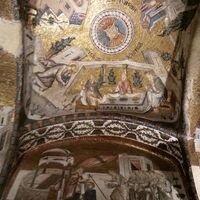 I’ll let you ponder what meal this mosaic is depicting.
I’ll let you ponder what meal this mosaic is depicting.
In orthodox iconography the color deep blue is the color of purity, and sometimes when the emphasis is on external purity the figure wears a blue outer garment, and if on internal purity, a blue under garment. 
 Of course Christ is depicted both ways, but so is mother Mary….
Of course Christ is depicted both ways, but so is mother Mary…. The other way of indicating the holiness of a figure is of course to give them a halo, as in this image of the saints surrounding Christ on the throne, in this case the twelve apostles.
The other way of indicating the holiness of a figure is of course to give them a halo, as in this image of the saints surrounding Christ on the throne, in this case the twelve apostles. 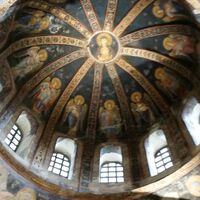 There is much more to see at this church, many scenes from the Gospels for example, the raising of Lazarus. This is a church that more Christian tourists should see, in addition to Hagia Sophia, as it tells an important tale about post Constantinian church life in Constantinople into the medieval period.
There is much more to see at this church, many scenes from the Gospels for example, the raising of Lazarus. This is a church that more Christian tourists should see, in addition to Hagia Sophia, as it tells an important tale about post Constantinian church life in Constantinople into the medieval period.


